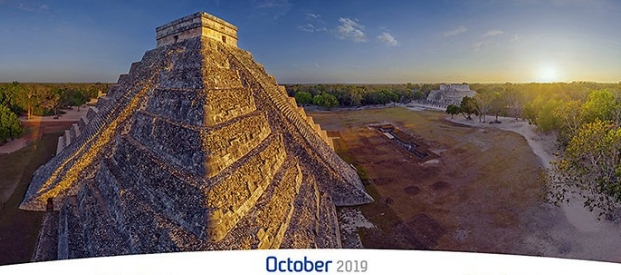A Calendar within a Calendar
At the heart of the ancient city-state of Chichen Itza stands a 30m high step pyramid, El Castillo, also known as The Kukulcan Pyramid. This is the tallest structure in one of the most amazing places in the world. Built by the Mayan people around 1100 AD, the pyramid is a temple to the feathered serpent god, Kukulcan. It dominates this world-renowned site, a planned city with clusters of pyramids and temples, which expanded from 750-900AD.
An ancient calendar
The Kukulcan Pyramid can also be described as one of the largest and most ancient calendars in the world. Each of its four sides has a stairway with 91 steps making 364 steps altogether. Add in one step at the top at the temple entrance and the steps total 365, representing the number of days in the Mayan calendar. The nine stepped stages, bisected by the staircases, may represent the eighteen months of the Mayan year.
The Mayan civilization was very advanced. The Maya began to develop writing as early as 700 BC. They soon began farming and building cities, and by 300 BC had adopted the idea of democracy. The first Mayan calendars were carved into stone around 400 BC.
The Mayan calendar consists of three calendars, the Long Count, the Tzolk’in, and the Haab’. These are used simultaneously although each has a cycle of a different length. The Long Count is an astronomical calendar which is used to track longer periods of time. It is renowned for seeming to predict the end of the world in 2012. The Haab’ is the civil calendar and is a solar calendar with a 365-day cycle divided into 18 months of 20 days each and one month of 5 days. The Tzolk’in has a 260-day cycle and is the divine calendar, used to determine the time of religious or ceremonial events.
The descending serpent
The city-state of Chichen Itza was the most powerful in the region and was the ruling state for 200 years. Standing the heart of the city and towering over other structures, the Kukulcan Pyramid shows off the superior understanding of astronomy, mathematics and architecture of the Maya. It is cleverly aligned and built so that twice a year, at the spring and autumn equinox, the light and shadows fall in such a way as to look like a giant serpent crawling down the temple. As the sun sets, eventually the shadow-snake links up with one of the enormous carved serpents’ heads at the base of the pyramid before disappearing into the ground. Crowds still gather to witness the spectacle at every equinox.
An innovative calendar for 2019
In 2019, for the month of October, our innovative calendar, 360interactive, shows a picture of that very ancient calendar, the Kukulcan Pyramid.
What makes 360interactive different from most other calendars is that it includes a QR code on every month. By scanning the code on a smart phone or tablet, users can take a virtual tour of the entire Chichen Itza site through an impressive 360° photosphere.
360interactive has already won five awards for innovation. We think it would impress even those clever Maya mathematicians and astronomers!










